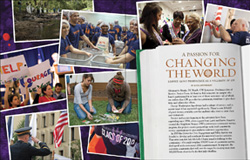A Passion for Changing the World
Service gains prominence as a hallmark of GW.
Alternative Breaks. DC Reads. GW Jumpstart. Freshman Day of Service. Senior Prom. It's hard to find someone on campus who hasn't participated in at least one of these activities—all of which are outlets that GW provides for community members to give their time and talents for others.
George Washington has always had a culture of service, and in recent years it has expanded significantly. There's even $30,000 of grant money available now for students who want to start their own initiatives.
Service and service-learning at the university have been expanding since 1994, when a grant from Learn and Serve America created the Neighbors Project. GW's cornerstone community service program, the project creates partnerships with local community service organizations to give students volunteer opportunities.
In 2009 the Center for Civic Engagement and Public Service was founded to develop and coordinate the university's service activities. That same year, first lady Michelle Obama issued a challenge to the community—if it could complete 100,000 hours of community service, she'd speak at the university's 2010 commencement. In response, the university community shot well over the target, by clocking more than 160,000 hours of service by the first lady's deadline.
The volume of this response demonstrates that service is more of an institutional priority than ever. In 2010 GW brought career-long public service and civic engagement expert Amy Cohen on board to direct the Center for Civic Engagement and Public Service.
"President Knapp has really made community service a priority," Ms. Cohen says. "The number of staff devoted to community service has grown each year since 2008. Students are serving; faculty members serve as a part of their research. It's highlighted all across the campus; and that is truly making us into a service university."
In the 2010-11 academic year, the Neighbors Project engaged 1,500 students in service to more than 40 community organizations in D.C., on issues from adult literacy—the GW chapter of DC Reads is the area's largest, with 500 students participating—to urban cleanup.
"The focus on community service might be stronger, but it's not new," Ms. Cohen points out. "Rather, it's continuing a tradition and strengthening a legacy that GW has already established."
Individual schools have long been on track with the effort to serve. At the Law School, which runs 13 different clinics, students have offered more than 40,000 pro bono service hours to D.C. residents; business students partner with area teens in mentorship programs; and medical students deliver care to people in need throughout the region and beyond.
Below, a few ways in which GW and its community members are giving back.
Freshman Day of Service
Members of the Class of 2015 didn't begin their college experience just by buying textbooks and school supplies. Rather, they gathered to paint murals, plant gardens, and clean up 12 D.C. public schools, two veterans' retirement homes, and local Fort Dupont Park.
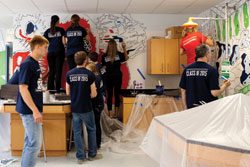
More than 2,000 students, staff members, and faculty members participated in GW's third annual Freshman Day of Service, held Sept. 11, 2011. The theme of the day, "Brightening Schools, Building Community," focused on beautifying local schools while introducing new GW students to their urban community.
Jessica McConnell Burt
Now a signature service event for the university, GW's Freshman Day of Service began in 2009. The inaugural event, held in honor of the National Day of Service and Remembrance established by President Obama, saw 1,200 students and faculty and staff members volunteering to serve veterans and military families across the D.C. metro region.
Participation in the event has increased yearly. In 2010, more than 2,000 GW community members took part in the environment- and sustainability-themed Day of Service, serving at 14 sites in the D.C. area. They also continued the tradition of serving for and with veterans by volunteering at the Armed Forces Retirement Home and Vinson Hall Military Retirement community.
This year's event, held in partnership with D.C. Public Schools, engaged more than 2,300 GW community members in beautification projects to understand the impact that learning environments can have on student success. The Corporation for National and Community Service pointed to the event in recognizing GW as a service leader.
Freshman Day of Service's timing at the beginning of the year makes it a particularly effective way to give entering freshmen a sense of common mission and purpose—while also emphasizing that this one-day event should be only the beginning of new GW students' commitment to service.
"Whether in Washington, D.C., or elsewhere in the nation or the world," President Knapp remarked in September, GW students are encouraged to "find your passion and continue to serve."
Veterans
Supporting Those Who Served
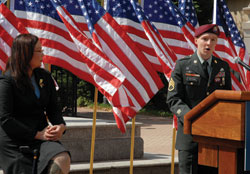
At a 2009 GW veterans event, GW graduate student-veteran Brian Hawthorne, BA '10, discusses GW's participation in the Yellow Ribbon Program alongside Tammy Duckworth, MA '92, former assistant secretary for public and intergovernmental affairs at the U.S. Department of Veterans Affairs.
Jessica McConnell Burt
Student veterans are at the forefront of GW's growing service effort, which is only natural, given the university's proximity to military headquarters and the number of GW students who are active military service members as well as veterans.
Graduate student Brian Hawthorne, BA '10, was instrumental in the planning and implementation of the first-ever Freshman Day of Service.
The university also assists the current generation of veterans, who play vital roles in shaping the culture of service on campus.
As part of its efforts, GW is one of the leading participants in the Yellow Ribbon Program, which is part of the G.I. Bill passed after 9/11. All eligible undergraduate student veterans, and now almost all eligible student veterans in graduate programs as well, receive full coverage of tuition through GW's Yellow Ribbon Program. (GW has a long history with the G.I. Bill: Donald Balfour, BA '45, was the first recipient of the original G.I. Bill.)
GW's Student Veterans' Services Office assists many of the approximately 700 student-veterans, active-duty service members, and dependents at the university. In November of this year, GW held one of several planned activities: its first annual Veterans Awareness Week to focus on veterans and veterans' issues and to honor and thank those who serve our country. The week's events included a day of service, book readings and signings, movie screenings, and "Thank a Vet" day.
In recognition of its efforts for veterans, George Washington also has been named a "military friendly" institution by G.I. Jobs magazine and a "best for vets" university by Military Times' Edge magazine.
Service-learning
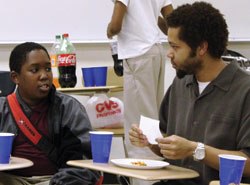
A student in Dr. Sam Steen's counseling class (right), serves as a tutor and counselor at an after-school program funded by a Department of Education grant.
For a semester, graduate students in Dr. Sam Steen's Foundations in School Counseling class served as tutors and group counselors at an after-school program funded by a Department of Education grant. Class members offered weekly tutoring and counseling services to local H.D. Woodson High School students, focusing on discussing opportunities for postsecondary education.
"I believe [service learning] had a tremendous impact on my students," says Dr. Steen, assistant professor of counseling in the Graduate School of Education and Human Development and a certified K-12 school counselor. "I got a sense that they grew in ways that they didn't realize that they could."
Service-learning makes the academic experience more than merely academic—and gives students a more rigorous service experience than just volunteering. The practical implications of traditional, theoretical classroom lessons are brought home through significant, challenging community service projects.
GW's service-learning offerings, coordinated through the Center for Civic Engagement and Public Service, have expanded steadily in the past few years. The university now offers more than 50 service-learning classes across the disciplines.
These courses range from introductory-level to capstone classes and span fields from nonprofit management to geography, at both the undergraduate and graduate levels. Service-learning students work closely with faculty members to use classroom expertise to help schools, local nonprofits, small businesses, and government agencies.
In Dr. Steen's class, students drew on their experience at Woodson—along with the traditional course readings and structured class discussions—to better understand the achievement gap between students of color and their white counterparts, and to study the impact of school counselors' services and interventions in schools. Woodson's student population is 100 percent black, with 85 percent using free or reduced-price lunch services.
Dr. Steen says service-learning is a great vehicle for increasing GW's culture of activism and for strengthening the university's ties to its community, and it has the additional reward of breaking down social barriers for his students.
Alternative Breaks
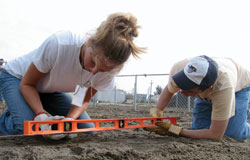
The Alternative Breaks program sends hundreds of students to an expanding list of destinations across the nation and the world. In the years since the program's inception, students have— among other activities—helped rebuild disaster-ravaged communities in New Orleans, worked to empower disadvantaged youth in Honduras, and worked on sustainable agriculture projects in Puerto Rico.
"Go forth and change the world," Collin Stevenson, BA '09, MA '11, told his classmates when closing his remarks as the student speaker at GW's 2010 commencement.
Mr. Stevenson knows firsthand how capable his peers are of bringing about global change. When he began participating in service trips to Hurricane Katrina-ravaged New Orleans in 2006—only six months after the storm—about 40 of his fellow students accompanied him. As he went on to lead Alternative Breaks trips to the city in subsequent years, first as a student leader and then as a staff "learning partner," a legal representative of the university and unofficial guide for student leaders, he watched the Alternative Breaks program grow tenfold from that initial group.
Students can now choose to spend their academic breaks serving in more than a dozen locations, from teaching and learning in the Cherokee Nation to building an elementary school out of recycled materials in Guatemala. Last year, nearly 450 students participated in this popular service program.
"Students enter GW from very diverse backgrounds," Mr. Stevenson says. "Sometimes the biggest shock is finding that we share a lot more than we thought in common with people of other cultures. Students wonder why certain disparities exist, and their worldviews are challenged by hearing, seeing, and feeling, firsthand, the challenges faced by others. The greatest value of the Alternative Breaks program is in this paradigm shift."
He adds, "I've read enough feedback and testimonials to know with confidence that these trips change lives, majors, career goals, and values in a long-term, systemic way."
Students "find community" through their participation in these global programs, Mr. Stevenson says. "It's tough to change the world on your own, but lasting friendships are forged through this shared experience based in shared values."
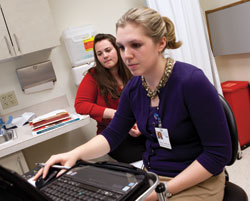
Students work in the GW HEALing Clinic, which is staffed by students from GW's School of Medicine and Health Sciences and School of Public Health and Health Services and provides health services and information to residents in D.C.'s Shaw and Anacostia neighborhoods.
William Atkins
Medical and Health Service
In October 2011, cardiologists from GW's Cheney Cardiovascular Institute led a "health brigade" to Comayagua, Honduras. During the 11-day trip, they not only provided screening tests and medication to the 120 patients who traveled far and wide to get care, but also implanted 25 pacemakers and defibrillators in patients suffering from severe conditions.
Back in D.C., medical and public health students were also helping out close to home. The GW HEALing (Healthcare, Education and Active Living) Clinic has helped expand health care access since its founding in 2006. The after-hours clinic, operated by student volunteers, provides screenings, primary care services, and health information to residents in the Shaw/Howard and Anacostia neighborhoods—regardless of their insurance status or ability to pay.
Health care initiatives, both local and international, have a crucial role to play in GW's pantheon of service options. In September, students, faculty, and staff of the School of Medicine and Health Sciences put together bags of food for malnourished Somalis. Faculty members, students, and medical school alumni also traveled around the world, from Haiti to Sudan, to spread public health information and to provide disaster relief.
One standout program among many is the Interdisciplinary Student Community Patient Education Service (ISCOPES) project. One of the few programs of its kind in the country, ISCOPES places students in the health care professions—physicians assistants, physical therapists, and public health students as well as nurses and doctors—together in multidisciplinary teams. These teams then link up with community organizations for an entire year, working to solve a community health issue. In 2010-11, according to its annual report, ISCOPES participants taught workshops on healthful diet and physical exercise, gave individual attention to clients learning to use a computer, and developed resource guides to help give D.C. residents access to crucial health service providers.
Service Corps and Public Service
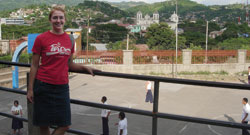
Karen Brunbaugh, BA '03, in Matagalpa, Nicaragua, where she served as a Peace Corps volunteer focusing on maternal health. For more information about GW's Peace Corps alumni, read our feature story on this topic in the early fall 2011 edition at www.gwmagazine.com.
After graduation, GW students continue to serve. For three years GW has been, of all mid-sized universities, the top contributor of Peace Corps volunteers. Seven percent of the graduating class of 2010 applied to Teach for America; the university acceptance rate for the program is 32 percent, more than double the national average of 14.5 percent.
"Our alumni are deeply engaged in service in their own communities," says Amy Cohen. "Getting together for a service event is a fun way for alumni to build community and re-create GW's legacy of civic engagement."
The buildup to a strong alumni connection to service begins during students' time at GW, where the career office focuses on making public service jobs accessible. GW has some of the highest number of off-campus professional opportunities in the nation—and 40 percent of federal work study jobs are in the government and nonprofit sectors. Initiatives like the Call to Serve campaign help keep students informed of opportunities to serve in the federal government.
These collegiate experiences often lead directly to jobs after graduation. Famously, GW alumni like Tammy Duckworth, MA '92, Colin Powell, MBA '71, and Mark Warner, BA '77, have dedicated their careers to varying avenues of service.
For more information on service at GW, visit serve.gwu.edu.
Alternate Break Destinations, Past and Present
United States |
International |
A Global Initiative
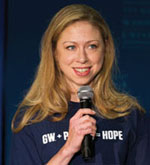
Chelsea Clinton helps kick off the GW + Phones = Hope Campaign at a rally in October. The used cell phone collection drive will help fund maternal and child health projects.
William Atkins
The Clinton Global Initiative chose George Washington University to host the next Clinton Global Initiative University in spring 2012, when CGI U will come to the nation's capital for the first time. Established in 2007 by President Bill Clinton, the event provides a forum for students, domestic and international, to engage with global leaders on some of the most pressing challenges of the day.
"As an institution known for its campuswide commitment to community service and fostering the next generation of leaders," President Clinton says, GW "will provide the perfect venue for…young leaders to join together and take action to effect global change."
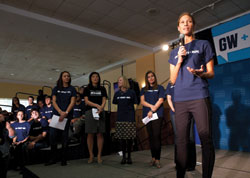
Christy Turlington Burns, founder of Every Mother Counts, speaks about maternal and child health advocacy at the rally. GW has made a commitment to collect 20,000 used cell phones.
Jessica McConnell Burt
From March 30 to April 1, 2012, high-profile speakers—including current and former heads of state, Nobel Peace Prize winners, major philanthropists, CEOs, and directors of nongovernmental organizations—and about 1,200 students will create their own "Commitment to Action." This concrete plan will address an issue within CGI U's focus areas: education, environment and climate change, peace and human rights, poverty alleviation, and public health.
In October, as part of gearing up for CGI U's arrival, George Washington also launched its GW + Phones = Hope Campaign, an effort to collect 20,000 used cell phones by March 2012. Proceeds from the recycled phones will go to fund two maternal and child health projects, one in the Democratic Republic of the Congo and one in Nepal.
GW Alumni are encouraged to participate in the GW + Phones = Hope Campaign. Visit gwu.edu/donate-phones to register your cell phone and portable electronics donations and download a prepaid mailing label. For more information, visit www.gwu.edu/donate-phones or send an email to donate-phones@gwu.edu.

